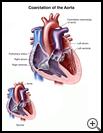
Coarctation of the Aorta
________________________________________________________________________
KEY POINTS
- Coarctation of the aorta is a narrowing of the big artery, the aorta, that pumps blood from the heart to the rest of body. This makes it hard for the blood to flow from the heart to the lower part of the body.
- Even if the defect is not causing any symptoms, surgery is needed to prevent high blood pressure from getting worse over time. Severe coarctation of the aorta in a newborn infant is a medical emergency that can result in death if it’s not treated.
- Follow your child’s healthcare provider's instructions. Ask your provider how to take care of your child at home.
________________________________________________________________________
What is coarctation of the aorta?
Coarctation of the aorta is a narrowing of the big artery, the aorta, that pumps blood from the heart to the rest of body. This makes it hard for the blood to flow from the heart to the lower part of the body. The blood backs up before the narrow area, causing higher blood pressure in the arms and in the blood vessels going to the head rather than to the legs. In severe cases, no blood can get through the narrow area. Severe coarctation of the aorta in a newborn infant is a medical emergency that can cause death if it’s not treated.
What is the cause?
The cause of this birth defect is not known. Sometimes it happens with other heart defects or with certain genetic disorders. Inside each cell of the body are genes. Genes contain the information that tells the body how to develop and work. Changes in the genes can be passed from parents to children.
What are the symptoms?
Depending upon how severe the narrowing and how much it changes normal blood flow, the baby may develop symptoms in hours to days, or may not develop any symptoms for years. If the narrowing is severe at birth, the baby will have symptoms that may include:
- Poor feeding
- Paleness
- Fast breathing
The lack of blood flow to the lower part of the body may cause the baby to stop making urine.
Symptoms in older children may include:
- Chest pain with exercise
- Cold arms or legs
- Pain in the legs with exercise
- Headache
- Nosebleeds
- Dizziness or lightheadedness
- Poor growth
How is it diagnosed?
Infants may be diagnosed in the first few days of life or at well-child exams later. Tests may include:
- An echocardiogram, which uses sound waves (ultrasound) to show pictures of the heart and how well blood is flowing through it
- Heart catheterization, which uses a small tube called a catheter inserted into a blood vessel, contrast dye, and X-rays to look at the aorta and surrounding blood vessels
- MRI, which uses a strong magnetic field and radio waves to show detailed pictures of the heart and blood vessels
How is it treated?
Even if the defect is not causing any symptoms, surgery is needed to prevent high blood pressure from getting worse over time. Surgery is usually recommended once the diagnosis is made and is usually done while the child is an infant. The surgery may be done in one of several ways:
- The narrow part of the aorta may be removed and the 2 ends reconnected.
- The narrow part of the aorta may be removed and replaced with a piece of synthetic material to enlarge the aorta.
- A tiny balloon may be inserted into the aorta to stretch the narrow section.
Most children who have successful treatment have no more symptoms and can lead normal lives. Older children will usually still have high blood pressure that needs to be treated. Sometimes the narrowing comes back when a child is older.
How can I take care of my child?
Your child will need to have regular follow-up visits with your healthcare provider and usually a heart specialist.
Follow your child’s healthcare provider's instructions. Ask your provider:
- How and when you will get your child’s test results
- How long it will take for your child to recover
- If there are activities your child should avoid and when your child can return to normal activities
- How to take care of your child at home
- If your child should take antibiotic medicine to prevent infection before having dental work or procedures that involve the rectum, bladder, or vagina
- What symptoms or problems you should watch for and what to do if your child has them
Make sure you know when your child should come back for a checkup. Keep all appointments for provider visits or tests.
Last modified: 2020-11-24
Last reviewed: 2020-11-09

